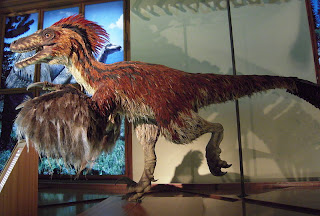 One of my favorite movies ever, Jurassic Park, came out twenty years ago this month! And though it's not the most scientifically accurate movie ever, it does make some great comments about the Bird-Dinosaur evolutionary relationship.
One of my favorite movies ever, Jurassic Park, came out twenty years ago this month! And though it's not the most scientifically accurate movie ever, it does make some great comments about the Bird-Dinosaur evolutionary relationship.Today's animal, Deinonychus, is an excellent example of that link, and (fun fact) it is also the inspiration for the Velociraptors in the movie! (Real Velociraptors were much smaller in size-- but have a much easier to pronounce name. At least the two were members of the same subfamily!) They lived during the Cretaceous period, around 115-108 million years ago, and their fossils have been found in western North America.
Deinonychus means "terrible claw," an appropriate name for them since they had massive claws on their feet that they used to slash at their prey. They also hunted in packs, as evidenced by the grouped fossils that have been found. (Sound similar to the movie Raptors?)
Deinonychus may have also had feathers, though that is up for some debate. No skin impressions have been found, but many other close relatives to Deinonychus, including Velociraptor and Microraptor, did most-assuredly have feathers. So it is likely that they did too!
Feathers or not, Deinonychus is incredibly important to our modern theories on Dinosaur-Bird evolution. John Ostrom, the Paleontologist who first extensively studied and named Deinonychus, used his work on the species to propose numbers theories that had never been brought up before. In the late 1960s he proposed that these fast, agile predators had to have been warm-blooded. And in the mid 1970s he compared the feet of Deinonychus to those of Birds, a hypothesis that eventually led to the near-universally accepted theory that Birds evolved from Dinosaurs!
Status : Extinct for 108 Million Years
Location : North America
Size : Length up to 11ft (3.4m)
Classification : Phylum : Chordata -- Class : Reptilia -- Order : Saurischia
Family : †Dromaeosauridae -- Genus : †Deinonychus -- Species : † D. antirrhopus
Image : Domser
Family : †Dromaeosauridae -- Genus : †Deinonychus -- Species : † D. antirrhopus
Comments
Post a Comment